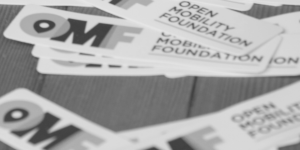Making it Official
The Open Mobility Foundation has long worked closely with the MobilityData team. As two open source, membership organizations developing data specifications, we have a lot in common – most importantly, our mutual commitment to developing technical tools aimed at improving the safety, equity, efficiency, and sustainability of our transportation systems.
That’s why we’re thrilled to announce that MobilityData has joined OMF’s Advisory Committee. And, the OMF has become a member of MobilityData. We hope this mutual relationship furthers our shared goals and helps our communities better understand what we do, and how we can continue to work together for the benefit of the mobility ecosystem.
On that note, the most common questions we get are around how we work together, and the major data specifications that we steward: GBFS and MDS.
Understanding the Relationship between GBFS and MDS
The General Bikeshare Feed Specification (GBFS) and Mobility Data Specification (MDS) are two open source data standards used for expressing information about bikes, scooters, and other shared mobility vehicles operating on public streets. GBFS is intended for public consumption through consumer-facing applications, while MDS is intended for use only by mobility providers and the public agencies charged with managing them, not the general public. GBFS is governed by MobilityData, and MDS is managed by the Open Mobility Foundation. While the specifications serve different purposes, they – like our organizations – work closely together.
Here’s a simple breakdown of the similarities and differences between each data specification:
| GBFS | MDS | |
| Why do cities use it? |
|
|
| Who is it for? |
|
|
| What type of vehicles does it cover? |
|
|
| How is the data formatted and delivered? |
|
|
More than 130 regulatory agencies around the world require micromobility operators to provide them with data through MDS. From standardizing the process and format of how data is shared to providing public agencies with the information they need to manage public streets and plan critical improvements, MDS is a powerful tool for managing shared mobility programs.
Any operator that fully complies with the MDS Provider feed is, per the MDS specification, also required to publish a public GBFS feed. This GBFS feed is useful for residents and can give regulators a useful cross reference for MDS data.
Public GBFS feeds can also encourage a competitive ecosystem of mobility service providers. GBFS aids in the discovery of available vehicles and enables the existence of consumer facing aggregator apps which allow users to see all available vehicles across multiple providers. Regulators may increase access to mobility services by requiring a provider to publish a public GBFS feed. And, MobilityData maintains a catalog of links to over 640 GBFS datasets available to the public.
Aligning GBFS and MDS
While the two specifications were created independently of each other and serve different primary purposes, many organizations implement both. To reduce technical burden and increase the utility of both GBFS and MDS, the OMF and MobilityData work together to increase alignment between the specifications – we attend each other’s planning calls, participate in both open source communities on GitHub, and regularly review planned changes to find opportunities for potential alignment.
While there is no plan to fully reconcile GBFS and MDS, as new features are added there may be more opportunities to use shared data models, enumerations, nomenclature, or other technical structures. Ultimately, each specification will remain independently governed to serve its unique purpose, but the data ecosystem will be stronger as MobilityData and the Open Mobility Foundation coordinate and communicate about the direction of our respective work.




